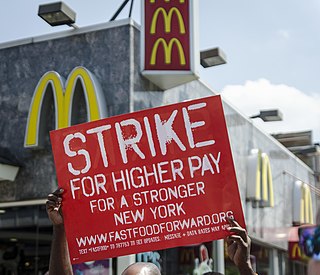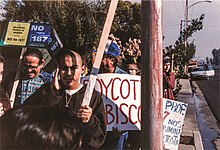
The Immigration Reform and Control Act was passed by the 99th United States Congress and signed into law by U.S. President Ronald Reagan on November 6, 1986.

Immigration is the international movement of people to a destination country of which they are not usual residents or where they do not possess nationality in order to settle as permanent residents. Commuters, tourists, and other short-term stays in a destination country do not fall under the definition of immigration or migration; seasonal labour immigration is sometimes included, however.

Foreign nationals (aliens) can violate US immigration laws by entering the United States unlawfully or lawfully entering but then remaining after the expiration of their visas, parole, or temporary protected status. Illegal immigration has been a matter of intense debate in the United States since the 1980s.

The economic impact of immigration is an important topic in Canada. Two conflicting narratives exist: 1) higher immigration levels help to increase economy (GDP) and 2) higher immigration levels decreases GDP per capita or living standards for the resident population and leads to diseconomies of scale in terms of overcrowding of hospitals, schools and recreational facilities, deteriorating environment, increase in cost of services, increase in cost of housing, etc. A commonly supported argument is that impact on GDP is not an effective metric for immigration. Another narrative for immigration is replacement of the ageing workforce. However, economists note that increasing immigration rates is not an effective strategy to counter this entirely. Policy Options found that mass immigration has a null effect on GDP. Increased immigration numbers and the associated soaring housing prices has significantly contributed to the rise of inflation in 2021 to the highest in 18 years.
Illegal immigration is the migration of people into a country in violation of that country's immigration laws, or the continuous residence in a country without the legal right to. Illegal immigration tends to be financially upward, from poorer to richer countries. Illegal residence in another country creates the risk of detention, deportation, and/or other sanctions.

The actual size and the origin of the illegal alien population in the United States is uncertain and is difficult to ascertain because of difficulty in accurately counting individuals in this population. Figures from national surveys, administrative data and other sources of information vary widely. By all measures, the population of illegal aliens in the USA declined substantially from 2007 until at least 2018. The number of border apprehensions substantially declined after 2000, reaching a low in 2017, but have recently rebounded to reach a new peak level as of 2021.
The New Americans: Economic, Demographic, and Fiscal Effects of Immigration is a 1997 study on the demographic, economic, and fiscal consequences of immigration to the United States by the National Research Council (NRC) of the National Academy of Sciences. The NRC report found that although immigrants, especially those from Latin America, were a net cost in terms of taxes paid versus social services received, overall immigration was a net economic gain due to an increase in pay for higher-skilled workers, lower prices for goods and services produced by immigrant labor, and more efficiency and lower wages for some owners of capital. The report also notes that although immigrant workers compete with domestic workers for some low skilled jobs, some immigrants specialize in activities that otherwise would not exist in an area, and thus are performing services that otherwise would not exist, and thus can be beneficial for all domestic residents. U.S. Census Bureau's Survey of Business Owners: Hispanic-Owned Firms: 2002 indicated that the number of Hispanic-owned businesses in the United States grew to nearly 1.6 million in 2002. Those Hispanic-owned businesses generated about $222 billion in revenue. The report notes that the burden of poor immigrants is not born equally among states, and is most heavy in California.
The Security Through Regularized Immigration and a Vibrant Economy Act of 2007 or STRIVE Act of 2007 is proposed United States legislation designed to address the problem of illegal immigration, introduced into the United States House of Representatives. Its supporters claim it would toughen border security, increase enforcement of and criminal penalties for illegal immigration, and establish an employment verification system to identify illegal aliens working in the United States. It would also establish new programs for both illegal aliens and new immigrant workers to achieve legal citizenship. Critics allege that the bill would turn law enforcement agencies into social welfare agencies as it would not allow CBP to detain illegal immigrants that are eligible for Z-visas and would grant amnesty to millions of illegal aliens with very few restrictions.

Immigration to Greece percentage of foreign populations in Greece is 7.1% in proportion to the total population of the country. Moreover, between 9 and 11% of the registered Greek labor force of 4.4 million are foreigners. Migrants additionally make up 25% of wage and salary earners.
In United States government contracting, a prevailing wage is defined as the hourly wage, usual benefits and overtime, paid to the majority of workers, laborers, and mechanics within a particular area. This is usually the union wage.
Unreported employment, also known as money under the table, working under the table, off the books, cash-in-the-claw, money-in-the-paw, or illicit work is illegal employment that is not reported to the government. The employer or the employee often does so for tax evasion or avoiding and violating other laws such as obtaining unemployment benefits while being employed. The working contract is made without social security costs and does typically not provide health insurance, paid parental leave, paid vacation or pension funds. It is a part of what has been called the underground economy, shadow economy, black market or the non-observed economy.
The economic policy of the Barack Obama administration, or in its colloquial portmanteau form "Obamanomics", was characterized by moderate tax increases on higher income Americans designed to fund health care reform, reduce the federal budget deficit, and decrease income inequality. President Obama's first term (2009–2013) included measures designed to address the Great Recession and subprime mortgage crisis, which began in 2007. These included a major stimulus package, banking regulation, and comprehensive healthcare reform. As the economy improved and job creation continued during his second term (2013–2017), the Bush tax cuts were allowed to expire for the highest income taxpayers and a spending sequester (cap) was implemented, to further reduce the deficit back to typical historical levels. The number of persons without health insurance was reduced by 20 million, reaching a record low level as a percent of the population. By the end of his second term, the number of persons with jobs, real median household income, stock market, and real household net worth were all at record levels, while the unemployment rate was well below historical average.
There are thought to be over half a million undocumented immigrants residing in New York City. They come from many parts of the world, especially Latin America, Asia, Eastern Europe, and the Caribbean. About 70% of them have paid work, in catering, construction, retail, driving, cleaning, and many other trades; at least in catering, their wages tend to be lower than those of comparable workers.

Wage theft is the failing to pay wages or provide employee benefits owed to an employee by contract or law. It can be conducted by employers in various ways, among them failing to pay overtime; violating minimum-wage laws; the misclassification of employees as independent contractors; illegal deductions in pay; forcing employees to work "off the clock", not paying annual leave or holiday entitlements, or simply not paying an employee at all.
The United States Chained Consumer Price Index (C-CPI-U), also known as chain-weighted CPI or chain-linked CPI is a time series measure of price levels of consumer goods and services created by the Bureau of Labor Statistics as an alternative to the US Consumer Price Index. It is based on the idea that when prices of different goods change at different rates, consumers will adjust their purchasing patterns by purchasing more of products whose relative prices have declined and fewer of those whose relative price has increased. This reduces the cost of living reported, but has no change on the cost of living; it is simply a way of accounting for a microeconomic "substitution effect." The "fixed weight" CPI also takes such substitutions into account, but does so through a periodic adjustment of the "basket of goods" that it represents, rather than through a continuous adjustment in that basket. Application of the chained CPI to federal benefits has been controversially proposed to reduce the federal deficit.

The 1992 Southern California drywall strike was a strike by Mexican and Mexican American drywall hangers, many of whom were undocumented, for fair wages and health insurance from contractors, who stole two billion dollars a years in income taxes, social security, and worker's compensation payments from the workers and collaborated with the local police to repress the organizers. Jesus Gomez, leader of the strike, received threats and had shots fired at his home, while key organizers were tailed by the police and even followed with helicopters. Eventually aligning with the United Brotherhood of Carpenters and Joiners, the strikers succeeded in getting union contracts that ensured fair wages and benefits. The strike left the residential construction industry in a different state. While the industry remained an open shop, contractors were forced to pay Mexican workers with wages and benefits closer to that of the white workers.

The Fight for $15 is an American political movement advocating for the minimum wage to be raised to USD$15 per hour. The federal minimum wage was last set at $7.25 per hour in 2009. The movement has involved strikes by child care, home healthcare, airport, gas station, convenience store, and fast food workers for increased wages and the right to form a labor union. The "Fight for $15" movement started in 2012, in response to workers' inability to cover their costs on such a low salary, as well as the stressful work conditions of many of the service jobs which pay the minimum wage.
Job creation and unemployment are affected by factors such as aggregate demand, global competition, education, automation, and demographics. These factors can affect the number of workers, the duration of unemployment, and wage rates.

The economic policy of the Donald Trump administration was characterized by the individual and corporate tax cuts, attempts to repeal the Affordable Care Act ("Obamacare"), trade protectionism, immigration restriction, deregulation focused on the energy and financial sectors, and responses to the COVID-19 pandemic.
Immigration to the United States has many effects on the culture and politics of the United States.










